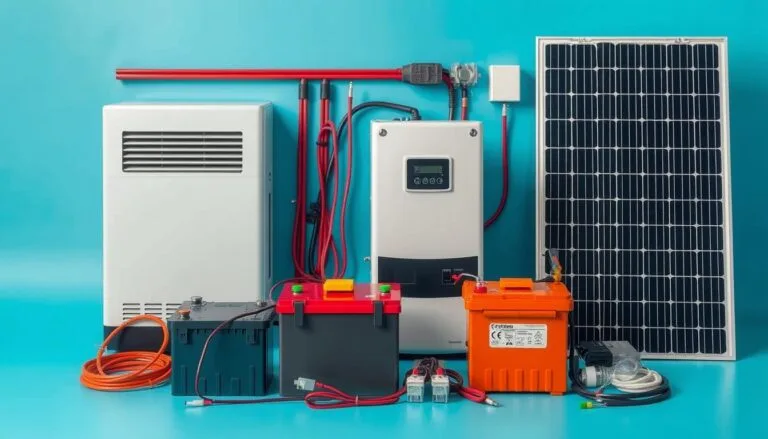Imagine reliable power at home, day or night. Today’s modern battery storage options turn midday panel output into overnight comfort. Homeowners can weigh price, capacity, and warranty to match a system with real needs.
Leading brands now offer long warranties and high roundtrip efficiency. Models like Tesla Powerwall 3 and FranklinWH aPower 2 show how lithium iron phosphate chemistry boosts cycle life and safety. Typical installed costs land near $9,400 after federal credits for a 13.5 kWh unit, making this an accessible investment for many.
Deep cycle designs give resilience during outages and help optimize utility rates. Comparing price per kWh, power ratings, and integration options helps reveal true value beyond the sticker number.
Key Takeaways
- Battery storage turns panel output into backup power and daily savings.
- Compare warranty, kWh capacity, and roundtrip efficiency—not just price.
- Lithium iron phosphate options deliver long cycle life and low maintenance.
- Price per kWh and cost per cycle show the true investment value.
- AC vs DC integration and power ratings determine system fit for your home.
- Top models vary by capacity and warranty; match specs to backup needs.
Why choose solar batteries now: reliable backup and long-term energy independence
A home energy reserve reduces reliance on the grid and protects your family during outages.
Build peace of mind with backup power that keeps refrigeration, lights, comms, and medical devices running without the noise or fumes of a generator.
Store excess daytime solar power to cover evenings and curb high time-of-use rates. That makes monthly electricity bills steadier and helps in areas with limited net metering.
- Think of a battery as an investment that pays value over years.
- Size the system for your risk: multi-day autonomy for frequent outages or a compact unit for brief blinks.
- Weigh price against roundtrip efficiency and warranty to get lasting, bankable capability.
“Choosing storage today can preserve comfort, reduce bills, and raise home value.”
Factor federal tax credits and local incentives to improve payback. Plan for EV charging or electric heat so your choice scales as needs grow.
What solar batteries do in a home solar panel system
A home’s generation, storage, and inverter work together to create a simple, reliable energy loop. That loop turns daylight into usable energy and keeps essentials running after the sun sets.
From solar panels to storage to inverter: how the energy flows
Solar panels produce DC current. A charge controller then manages charging and protects the battery bank from overcharge.
The stored power moves through the inverter, which converts DC into household AC electricity. The inverter must match your loads to avoid bottlenecks.
Deep cycle storage vs car batteries: why cycle life matters
Deep cycle designs tolerate repeated discharge and recharge. Starter car cells deliver short bursts and fail quickly under daily cycling.
- Match voltages or use MPPT to let a higher-voltage array charge batteries efficiently.
- Avoid mixing old and new units or different chemistries.
- Lead acid banks often need shallower discharge; lithium iron phosphate gives more usable capacity and longer life.
Choose types solar batteries built for frequent cycling, monitor state of charge, and wire the system with proper protection for safe, long-lasting performance.
Best solar batteries of the present: top-rated picks and why they win
The latest generation of home energy packs focuses on long life, strong output, and clear value. Below are five leaders that stand out for efficiency, capacity, and real-world price considerations.
Villara VillaGrid LTO: industry-leading efficiency and 20-year warranty
11.5 kWh with 98.5% roundtrip efficiency and an industry-leading 20-year warranty. LTO chemistry delivers premium cycle life and high peak power for demanding loads.
FranklinWH aPower 2: scalable capacity and strong power output
15 kWh per unit, 90% efficiency, and AC-coupled flexibility. Scale up to 225 kWh for whole-home needs while preserving robust continuous and peak power.
SolaX Power T-BAT H 20: retrofit-friendly large single-module capacity
18 kWh in a single module, 95% efficiency, and AC/DC options. This design eases retrofits where wall space and installation simplicity matter most.
PointGuard Energy BatteryPack-8.0: modular DC-coupled stackability
7.8 kWh blocks with 97% efficiency. DC-coupled scaling to nearly 390 kWh makes it ideal for new builds that want maximum harvest and modular growth.
Tesla Powerwall 3: compelling price per kWh with hybrid inverter integration
13.5 kWh, 97.5% efficiency, hybrid inverter options, and a competitive market price near $983/kWh in 2024. A straightforward choice for many retrofit and new projects.
- Compare price per kWh, warranty length, and usable capacity to judge lifetime value.
- Match power specs to your loads—continuous vs peak output matters for appliances and motors.
- Consider chemistry —from iron phosphate battery staples to LTO for premium longevity—when planning long-term performance.
“Choose the unit that fits your daily use and growth plans — value shows over years, not just at install.”
Solar batteries
Home energy solutions now deliver resilience, savings, and cleaner electricity in one compact package.
- Strengthen your home’s resilience with instant backup power that runs essentials without fuel or noise.
- Shift daytime output to evening peaks to unlock time-of-use savings and lower monthly price volatility.
- Choose proven deep cycle designs for long life, low upkeep, and steady usable capacity.
- Scale a system over time so your investment grows with EVs, appliances, and changing needs.
Reduce lifetime price by weighing roundtrip efficiency, warranty, and cycle life. Smart monitoring keeps performance transparent and makes living with energy storage simple.
“Add storage to protect routines, cut peak costs, and support a cleaner grid.”
Make sure your design matches goals—critical loads or whole-home backup—so the chosen solar battery delivers the right balance of cost and capability.
Battery chemistry decoded: LFP, LTO, and NMC for home energy storage
Not all lithium designs behave the same — chemistry decides how long and how hard a pack can work.
Choose chemistry to match your goals: safety, usable life, and upfront price vary a lot. Understanding tradeoffs helps you pick the right option for everyday resilience and long-term value.
Lithium iron phosphate (LFP): safe, long-lasting, and widely adopted
LFP, often called iron phosphate, anchors most home systems for good reason.
Pros: strong safety, 5,000–8,000 cycles in many installs, low maintenance, and attractive price per usable kWh.
Lithium titanium oxide (LTO): premium longevity and power, higher upfront price
LTO delivers unmatched cycle life and fast recharge capability.
Tradeoff: higher upfront price and lower energy density make it a premium choice when years of heavy use and rapid recharge matter.
NMC: power-dense but less stable and shorter lifespan
NMC cells are compact and deliver high power for their weight.
Watch outs: thermal management and lower cycle life mean NMC is less common for stationary household use today.
- Tip: an iron phosphate battery often gives the best balance of safety, cycle life, and price for typical homeowners.
- Match settings: align charger and inverter controls to protect cycle life and preserve advertised performance.
“Align chemistry to use case — LFP for mainstream storage, LTO for premium durability, NMC when space is tight.”
AC vs DC coupling: choosing the right configuration for your solar energy system
Deciding how to tie storage into your array shapes efficiency, price, and future upgrades. The coupling choice affects installation time, usable output, and how the inverter coordinates solar harvest with a battery pack.
AC-coupled advantages for retrofits and microinverter systems
AC coupling shines when you add storage to an existing panel system. It often lowers upfront price and shortens downtime because installers keep the original inverter and add an AC-coupled battery inverter.
This path preserves panel-level optimization on roofs with shading or microinverters. It also simplifies service and lets you scale without replacing major gear.
DC-coupled efficiency gains for new solar-plus-storage builds
DC coupling is ideal for new builds that want top harvest. A hybrid inverter converts power only once, boosting roundtrip efficiency and increasing usable output over time.
- Pick AC to avoid replacing microinverters and to reduce soft costs.
- Pick DC for maximum efficiency and unified energy system control.
- Look for proven gear and accessories — even MidNite Solar components — and make sure wiring and protection match local code.
Capacity, power, and performance: how to read kWh, kW, and efficiency
Read capacity and power like a map — they tell you how long and how hard a unit will run your home.
Usable capacity and depth of discharge (DoD): what you can actually access
Capacity (kWh) is the total energy inside a pack, but usable capacity is what you can depend on each cycle.
Manufacturers list DoD to show safe extraction limits. Follow that guidance to protect warranty and cycle life.
Continuous vs peak power: running multiple loads and handling start-up surges
Continuous power (kW) determines how many devices run at once. Peak power covers short motor starts, like air conditioners or refrigerators.
For example, a 10 kWh battery can run a typical central AC for ~2 hours or many small loads for much longer. Match inverter output to avoid bottlenecks.
Roundtrip efficiency: where losses occur and why they matter
Roundtrip efficiency shows how many kWh come out per kWh put in. Higher efficiency lowers the effective price you pay for delivered energy.
Compare usable kWh, continuous/peak kW, and efficiency when you evaluate options. That helps you balance upfront price against long-term value and daily performance.
- Tip: plan load management so high draws don’t drain capacity fast.
- Tip: use DoD and warranty limits to preserve life and lower your price per usable kWh.
- Tip: include real-world system factors — wiring, temperature, and inverter — in your comparison.
“A clear spec sheet turns technical numbers into a reliable plan for home comfort and backup.”
Sizing your battery bank the right way
Begin with daily consumption in kWh, then layer in inverter losses and temperature derates to find the right bank size.
Start with real numbers: total daily kwh, desired days of autonomy, and the recommended depth of discharge for your chemistry.
Adjust that target for inverter efficiency and ambient temperature. Cold reduces usable capacity; heat shortens life. Factor both so the bank delivers when you need it.
Series vs parallel and limiting parallel strings
Use series wiring to reach the bank voltage your inverter expects. Add parallel strings to increase amp-hours, but limit parallel runs to avoid imbalance.
Never mix ages, voltages, or models in the same bank — identical units preserve longevity and performance.
Plan for growth
Size with future loads in mind: EV charging or new appliances can double demand. Choose modular deep cycle modules or leave headroom so upgrades don’t force a complete redesign.
- Include a quality MPPT charge controller and proven BOS gear like MidNite Solar.
- Design wiring, overcurrent protection, and disconnects for serviceability and safety.
- Balance price and practicality—one larger battery vs multiple modules affects install and maintenance.
“Make sure the bank matches real use, not just brochure numbers.”
Warranty and cycle life: protecting your investment for years
Warranty language shapes how long your system really protects your home. Read terms to know what the manufacturer guarantees over time and under what conditions. Typical offers run about ten years and include end-of-warranty capacity limits plus throughput or cycles clauses.
Term length, end-of-warranty capacity, and throughput
Check three items closely: the number of years covered, the guaranteed end-of-warranty capacity, and any total kwh or cycles cap that limits service life.
Use throughput math to test promises. For example, a 20,000 kwh warrantied throughput on a 10 kwh usable pack equals about 2,000 cycles.
How to compare real-world value
- Compare cycle life claims across chemistries and align charge habits to stay within warranty limits.
- Confirm triggers for service—capacity loss versus outright failure—and what labor or shipping the maker covers.
- Balance price and protection: a lower upfront price may cost more if coverage or capacity retention is weak.
- Document settings and firmware so claims are smooth and verifiable.
“A clear warranty turns specs into a predictable plan for replacement and real value.”
Tip: Backup-only use often stretches calendar years far beyond daily cycling estimates. Favor brands with clear data sheets and published capacity curves to budget replacement timing with confidence.
Price and value: comparing price per kWh, installation, and total cost of ownership
Upfront purchase price tells part of the story, but lifetime delivered energy reveals true value. Use a consistent usable-kWh baseline to compare offers. A 13.5 kWh pack typically installs for about $9,400 after credits, but that number hides many variables.
Translate headlines into price per kWh and cost per cycle. Factor roundtrip efficiency, warranty-backed usable capacity, and expected cycles to get a realistic cost-per-cycle figure. For example, known brand pricing near $983/kWh helps benchmark market expectations.
Balance-of-system and installation costs
Don’t ignore BOS line items: charge controller, inverter type, disconnects, racking, permits, and labor can double or more the hardware price. AC vs DC coupling affects labor and parts—DC-coupled builds can yield higher efficiency but cost more in new installs; AC works well for retrofits.
- Compare upfront price to lifetime value using a consistent kWh basis.
- Weigh premium features—higher efficiency, longer warranty, integrated hybrid inverter—against incremental cost.
- Expect reputable installers to provide transparent scopes and itemized estimates.
“A clear, normalized comparison lets you pick the energy system that delivers lasting value.”
Lead-acid vs lithium battery storage: different types, different outcomes
What you buy today can mean routine watering or decades of near‑no‑maintenance operation. Choosing between lead acid and modern lithium battery packs changes upkeep, weight, and long‑term value.
Flooded, AGM, and gel: maintenance and shorter lifespans
Flooded lead acid cells need watering and periodic equalizing. They often last 3–6 years with heavy use and shallower recommended deep cycle discharge.
Sealed lead acid and AGM reduce daily care but still trail lithium on usable capacity and weight. Gel options behave similarly and demand gentler charging to avoid damage.
Why modern lithium systems lead on weight, performance, and cycles
Lithium battery designs—especially lithium iron phosphate—give far higher energy density and lower mass. LiFePO4 often delivers 5,000–8,000 cycles and built‑in BMS protection.
That means fewer modules to hit the same usable kwh and a smaller footprint for your solar energy system. Compare not just sticker price but the long view: price per usable kWh and cost per warranted cycle.
- Tip: sealed lead acid reduces chores but costs more over time.
- Tip: choose lithium for lighter weight, higher capacity, and near‑no‑maintenance life.
- Tip: size banks using deep cycle ratings so your backup meets real needs.
“Replacing aging lead acid with LFP often unlocks more usable capacity and cleaner integration.”
LiFePO4 spotlight: safety, cycle life, and price-per-kWh advantages
Modern lithium iron phosphate cells pair thermal stability with thousands of reliable cycles. This chemistry is widely chosen because it blends safety, long life, and sensible cost for homeowners.
5,000–8,000 cycles, built-in BMS, and low-maintenance operation
Expect durability: LiFePO4 typically delivers 5,000–8,000 cycles and resists fast degradation over years.
Integrated BMS balances cells, enforces safe charge and discharge limits, and reduces hands‑on care. That turns complex chemistry into everyday reliability.
- Lower effective price per kWh: high usable capacity and long cycle life cut long‑term cost.
- Modular options: common 24V and 48V packs make scaling straightforward for whole‑home plans.
- Lightweight and compact: easier to install than older lead‑acid alternatives while supporting high start‑up loads.
“Choose iron phosphate for a practical balance of safety, longevity, and value.”
Grid-tied, hybrid, and off-grid setups: integrating panels, inverters, and generators
A hybrid setup turns a standard array into a resilient energy system that can island during blackouts. Convert a grid-tied installation into a backup-ready system by adding a dedicated battery bank and a second inverter or a hybrid inverter. That gives you automatic backup without scrapping the original panel system.
Retrofitting often uses AC-coupled batteries to avoid replacing microinverters. New builds usually favor DC-coupled hybrid inverters for higher roundtrip efficiency and cleaner wiring.
Backup power planning: critical loads vs whole-home storage
Decide whether to protect a few circuits or the whole house. Size capacity in kWh to match goals: essentials-only keeps price lower; whole-home storage needs much more capacity and a larger inverter.
Adding storage to an existing grid-tied system without starting over
AC-coupled retrofit options let you unlock backup power while keeping your current array and inverters. Use transfer switches and a critical-load subpanel so the system runs selected circuits automatically during an outage.
Generator integration and charge controllers for safe charging
Use a generator as a last-resort energy source and control it with a proper charge controller and transfer equipment. Coordinate inverter settings, surge handling, and generator start thresholds to protect the battery bank and avoid backfeed.
- Match inverter and battery specs for seamless islanding and surge needs.
- Budget realistically—retrofits cut electrical rework; DC-coupled new installs capture higher efficiency.
- Include robust BOS gear—disconnects, breakers, and trusted accessories like MidNite Solar.
- Pair smart monitoring so you can watch state of charge, generator starts, and load priorities in real time.
“Document critical circuits clearly so your system prioritizes safety and comfort without overtaxing storage.”
Environment and placement: weight, temperature, enclosure ratings, and space
Begin with site strength—mounting surfaces must handle the weight and offer safe clearance for maintenance. Pick a wall or floor area that meets load specs and keeps service panels reachable.
Protect performance by controlling temperature. Extremes shorten life and cut usable cycles, so choose a stable indoor spot or a rated outdoor enclosure that keeps operating ranges steady.
Confirm enclosure ratings for outdoor installs and verify fasteners, anchors, and seismic details meet local code. Leave room for added modules and conduit so future expansion is clean and economical.
- Minimize cable runs to reduce voltage drop and keep stored power available where you need it.
- Design for serviceability—allow access to disconnects, breakers, and communication ports for safe maintenance and firmware updates.
- Balance price and protection by investing in weatherproofing, bollards, or ventilation that preserve life without overspending.
“A carefully chosen site keeps your battery system safe, efficient, and ready to grow.”
Conclusion
A well-sized system keeps essentials running while stretching every dollar of production. Choose solar batteries that balance usable kWh, continuous and peak kW, roundtrip efficiency, and a clear warranty to get reliable power when you need it most.
Focus on real metrics rather than headline price. Compare usable capacity and efficiency to judge long-term value, and weigh installation type: AC coupling for easy retrofits, DC for new builds that chase top harvest and performance.
Plan for growth with modular designs and partner with reputable installers. Make sure your chosen solar battery and battery settings reflect critical-load goals, budget, and desired resilience so the system rewards you for years.


























